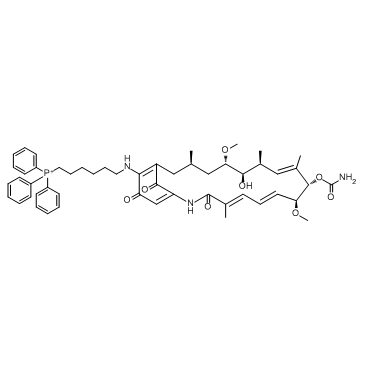| Cas No.: | 1131626-46-4 |
| SMILES: | O=C(C=C1NC(/C(C)=C/C=C/[C@H](OC)[C@@H](OC(N)=O)/C(C)=C/[C@H](C)[C@H]2O)=O)C(NCCCCCC[P+](C3=CC=CC=C3)(C4=CC=CC=C4)C5=CC=CC=C5)=C(C[C@H](C[C@@H]2OC)C)C1=O |
| Formula: | C52H65N3O8P |
| M.Wt: | 891.06 |
| Purity: | >98% |
| Sotrage: | 2 years -20°C Powder, 2 weeks 4°C in DMSO, 6 months -80°C in DMSO |
| Description: | In Vitro Within a 16-hour exposure, concentrations of Gamitrinib TPP of 15-20 μM indistinguishably kill patient-derived and cultured glioblastoma cell lines. This cell death response has the hallmarks of mitochondrial apoptosis, with loss of organelle inner membrane potential, release of cytochrome c in the cytosol, activation of initiator caspase-9 and effector caspase-3 and -7, and cellular reactivity for annexin V. Because Hsp90s are selectively present in mitochondria of tumor cells, but not normal tissues, Gamitrinib TPP does not kill normal fetal human astrocytes (FHAS). Under comparable conditions, nonsubcellularly targeted 17-AAG has no effect on normal or tumor cells. In Vivo Interestingly, 2 cycles of intracranial TRAIL combined with systemic G-TPP suppress the growth of established glioblastomas, with no significant animal weight loss throughout treatment. Analysis of brain sections from these mice, but not single agent-treated animals, show loss of tumor cell proliferation, internucleosomal DNA fragmentation, and caspase-3 activity, consistent with extensive activation of apoptosis in vivo. |

 To enhance service speed and avoid tariff delays, we've opened a US warehouse. All US orders ship directly from our US facility.
To enhance service speed and avoid tariff delays, we've opened a US warehouse. All US orders ship directly from our US facility.




















